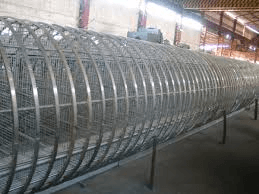Rod Baffles Heat Exchangers :
Rod Baffles heat exchangers are flow-directing or obstructing vanes or panels used in some industrial process vessels (tanks), such as shell and tube heat exchangers, chemical reactors and static mixers. Baffles are an integral part of the shell and tube heat exchanger design. The rod baffle is designed to support the bundles and direct the flow of fluids for maximum efficiency. Implementation of baffles is decided on the basis of size, cost and their ability to lend support to the tube bundles and direct substance flow.
Process:
Principles of rod baffles heat exchangers are Support the tubes for structural rigidity, preventing tube vibration and sagging. Divert the flow across the bundle to obtain a higher heat transfer coefficient Baffles are used to support tubes, enable a desirable velocity to be maintained for the shell side fluid, and prevent failure of tubes due to flow-induced vibration. Rod Baffles heat exchangers are serve two important functions. They support the tubes during assembly and operation and help prevent vibration from flow induced eddies and direct the shell side fluid back and forth across the tube bundle to provide effective velocity and Heat Transfer rates. The diameter of the baffle must be slightly less than the shell inside diameter to allow assembly, but must be close enough to avoid the substantial performance penalty caused by fluid bypass around the baffles. Shell roundness is important to achieve effective sealing against excessive bypass. Baffles can be made from a variety of materials compatible with the shell side fluid. They can be punched or machined. Some baffles are made by a punch which provides a lip around the tube hole to provide more surface against the tube and eliminate tube wall cutting from the baffle edge.
Image:

Advantages:
- Reduced pressure drop on shell side
- Increased process reliability
- Compact tubular heat exchanger
- Long running times due to turbulent flow
- Very low maintenance costs, minimum spares requirement
- Higher heat transfer coefficient (2-3 times) results in reduction in heat exchanger area up to 50%
- Fouling is minimised due to turbulence created by eddies at the periphery or tube wall
- High response to CIP
- Wide choice of MOC
- Uniform thermal processing
- More flexibility in annular space sizing
Applications:
- Communication Cabinet
- Electric control cabinet
- Charging stations
- Food industry: Juices, beverages, sauces, dairy, deserts, fruit puree, whole fruit, catering, convenient food, pasteurization.
- Industry: Chemical, petrochemical, polymers, heating, cooling, condensation, crystallization, evaporation, energy recovery.
6.Environmental: Waste water, environmental waste concentration, evaporation, sludge, pasteurization. - Bio-energy: Bio ethanol, biodiesel, biogas, cogeneration.

